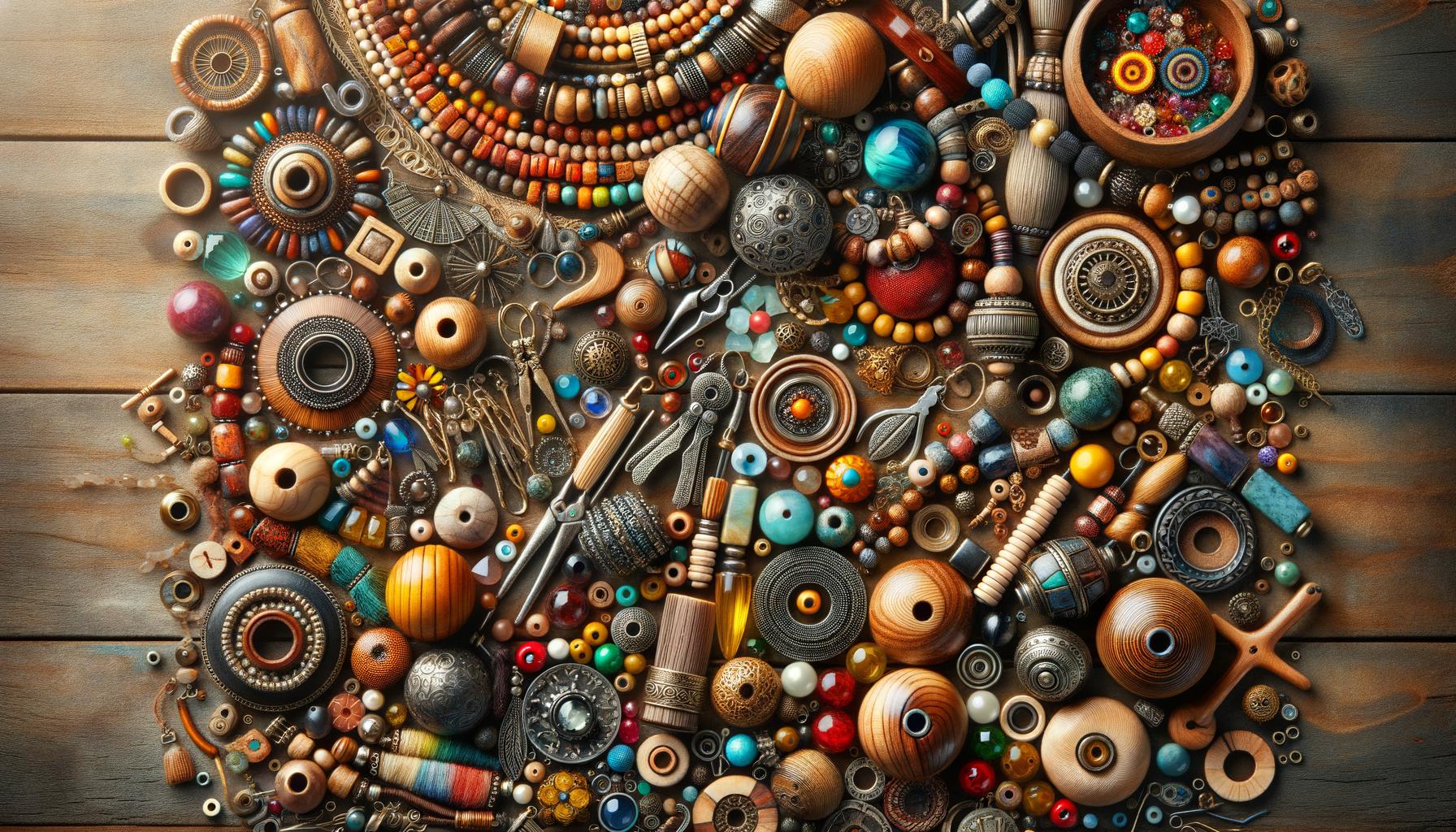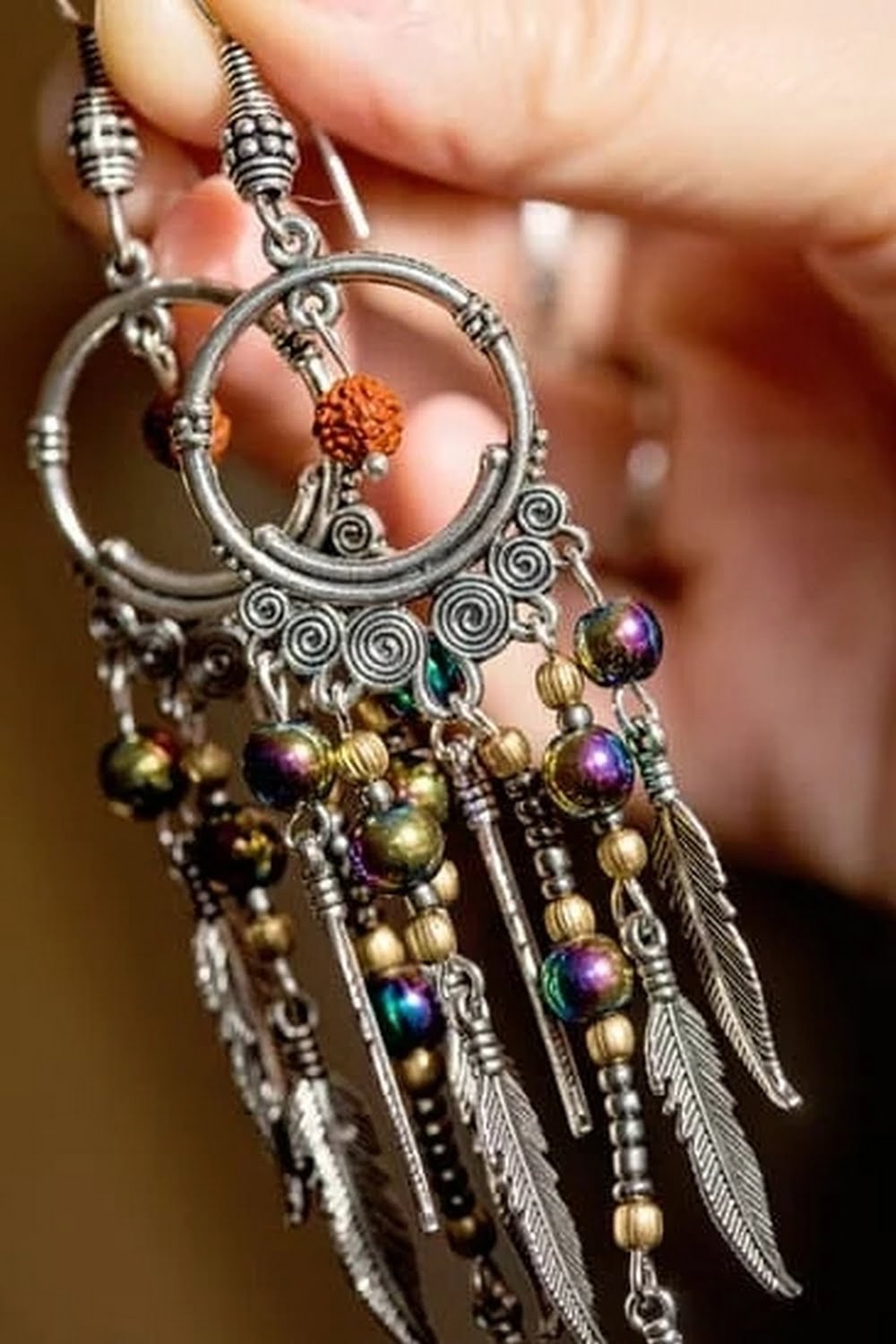Mixed media jewelry: combining materials for unique designs, merges the allure of diverse elements into wearable works of art. This innovative approach to jewelry making isn’t just about beauty; it’s a celebration of creativity and craftsmanship that invites artisans to push the boundaries of traditional jewelry design. By interweaving different materials such as metals, gemstones, textiles, and more, artists can craft pieces that stand out in an increasingly homogenized market.
The fusion of various materials opens up a realm of endless possibilities where each component not only contributes its inherent aesthetic appeal but also intertwines with others to produce stunningly intricate designs. The juxtaposition of rough textures with smooth surfaces or vivid colors against muted tones can create dynamic visual effects that captivate the eye.
Whether it’s the luster of metal paired with the earthiness of wood or the brilliance of gemstones mingling with rustic fabrics, mixed media jewelry offers a canvas where imagination knows no bounds.
Beyond its artistic allure, mixed media jewelry holds practical benefits as well. The process allows for greater versatility and durability in design, making it possible for jewelers to cater to diverse fashion trends and personal tastes.
Moreover, incorporating a variety of materials can lead to personalized pieces imbued with emotional significance. As we delve further into this article, you’ll discover the rich history behind these multi-material masterpieces and explore the techniques and inspirations driving today’s most captivating mixed media creations.
Historical Background
The evolution of mixed media jewelry can be traced back to ancient civilizations where artisans combined natural elements like bones, shells, and stones to create adornments. The Egyptians were among the pioneers in this domain, merging gold with colorful gemstones and glass beads to craft their signature pieces. This intermingling of materials was not just for aesthetic appeal but also for symbolic purposes, imbuing the jewelry with cultural and spiritual significance.
During the Renaissance period, mixed media jewelry saw a surge in popularity as craftsmen began incorporating enamel into metalwork, creating vibrant and intricate designs. This era also marked the introduction of new materials such as pearls and semi-precious stones that were seamlessly integrated into elaborate necklaces, brooches, and tiaras. The Renaissance passion for art extended to jewelry making, showcasing an advanced understanding of combining various elements harmoniously.
Fast forward to the 20th century, movements such as Art Nouveau and Art Deco embraced the concept of mixed media jewelry with open arms. Art Nouveau’s emphasis on natural forms led designers to blend metals with organic materials like wood and ivory.
Meanwhile, Art Deco’s fascination with industrial modernism saw innovative combinations of metals like platinum with bold geometric gemstones. These historical shifts not only highlight significant advances in technique but also illustrate how mixed media jewelry: combining materials for unique designs has always been a dynamic field reflecting broader artistic currents.
| Era | Materials Used |
|---|---|
| Ancient Civilizations | Bones, shells, stones |
| Renaissance | Enamel, pearls, semi-precious stones |
| Art Nouveau/Art Deco | Metals with wood/ivory (Art Nouveau); Platinum with geometric gemstones (Art Deco) |
Materials Commonly Used in Mixed Media Jewelry
In mixed media jewelry design, the selection of materials plays a crucial role in defining the piece’s aesthetic and functional attributes. Various materials are commonly used to combine their distinct properties, resulting in eye-catching and innovative designs. Metals like gold, silver, copper, and brass offer durability and a classic appeal.
Their ability to be molded, soldered, and polished makes them foundational elements in many mixed media pieces. When paired with softer materials such as textiles or leather, metal provides a striking contrast that can elevate both elements.
Gemstones are another popular choice due to their natural beauty and symbolic significance. They can be embedded into metals or woven into wire settings to create intricate patterns. Semi-precious stones such as turquoise, amethyst, and peridot are often favored for their variety of colors and textures. Additionally, incorporating organic materials like wood or bone introduces an earthy element that can make the jewelry feel more grounded and connected to nature.
Sustainable choices have also become increasingly important in modern jewelry design. Eco-friendly options include recycled metals, ethically sourced gemstones, and repurposed everyday objects such as broken glass or vintage buttons. Using these materials not only reduces environmental impact but also adds unique character to each piece. For those interested in crafting eco-conscious mixed media jewelry: combining materials for unique designs can result in one-of-a-kind items that resonate deeply with both the creator and the wearer.
- Metals: Gold, Silver, Copper, Brass
- Gemstones: Turquoise, Amethyst, Peridot
- Organics: Wood, Bone
- Sustainable Options: Recycled Metals, Ethically Sourced Gemstones
- Repurposed Items: Broken Glass, Vintage Buttons
By thoughtfully combining these varied materials using distinct techniques like weaving or embedding stones into settings crafted from metals or textiles – artists can create truly bespoke pieces of mixed media jewelry that celebrate diversity within design.
Techniques for Combining Different Materials
Mixed media jewelry, combining materials for unique designs, offers a plethora of techniques to achieve stunning effects and secure connections between diverse elements. One popular technique is soldering, which involves melting a filler metal to join two or more pieces of metal.
Soldering requires precision and practice, but it creates strong bonds ideal for intricate designs featuring metals like silver, gold, or copper. For those new to soldering, starting with basic projects can help build the necessary skills before tackling more complex combinations.
Beading is another versatile method commonly employed in mixed media jewelry. This technique allows artisans to weave beads in various patterns using thread or wire without requiring advanced equipment. Beading can incorporate materials such as glass, gemstones, wood, and even textiles to add texture and color variance to the pieces. Utilizing different bead sizes and shapes further enhances the design’s complexity while offering flexibility in endless patterns and styles.
Weaving presents yet another dimension of creativity by integrating fibers like silk, leather strips, or fine wires into base structures made from sturdier materials like metal frames or wooden bases. This technique not only adds tactile interest but also marries soft and hard textures beautifully. Similarly, embedding involves encasing smaller decorative elements within resin or other clear substances; it offers an innovative way to preserve delicate inclusions such as dried flowers or tiny shells within durable settings.
| Technique | Examples of Materials |
|---|---|
| Soldering | Gold, Silver, Copper |
| Beading | Glass beads, Gemstones, Wood beads |
| Weaving | Silk threads, Leather strips, Fine wires |
| Embedding | Dried flowers within resin |
Of course, these techniques require practice and sometimes specialized tools to master fully. Nonetheless, understanding how each method functions can vastly improve the craftsmanship of mixed media jewelry pieces while opening up endless possibilities for innovative design exploration.
Design Inspiration
We derive inspiration for mixed media jewelry from a myriad of sources, each offering a unique perspective and richness to the final designs. Nature stands as one of the most profound inspirations, with its vast array of organic shapes, colors, and textures.
Envision a piece influenced by the serene beauty of seashells combined with vibrant gemstones and metals; such juxtapositions capture the essence of natural elegance. Likewise, patterns found in leaves, flowers, and landscapes provide endless possibilities for creating visually stunning jewelry.
When it comes to cultural artifacts, delving into history can be incredibly rewarding. Different eras and regions offer distinct artistic expressions that can be reimagined in contemporary mixed media jewelry. Ancient Egyptian jewelry often incorporated gold with intricate beadwork while tribal adornments utilized materials like bone and feathers.
These historical precedents can serve as a springboard for your creativity, allowing you to blend traditional elements with modern materials to craft something truly remarkable. Mixed media jewelry: combining materials for unique designs allows you to pay homage to different cultures while showcasing your innovative approach.
Contemporary art also offers an abundant source of inspiration for designing unique pieces. Artists across different mediums-whether it’s abstract painting or sculpture-can introduce new ways to think about form and texture. For instance:
- Abstract Art: Utilize bold colors and geometric shapes.
- Modern Sculpture: Inspire asymmetrical forms crafted from metals paired with softer materials like textiles.
- Street Art: Incorporate urban vibes using unconventional items like repurposed graffiti fragments or industrial objects.
Interviews with established mixed media jewelry artists reveal diverse approaches in developing a personal style or theme. Some artists might find inspiration through travel experiences or personal stories, integrating emotional significance into their work by combining sentimental objects such as family heirlooms with contemporary elements. This infusion of personal narrative not only makes each piece distinctive but also imbues it with deeper meaning and emotional resonance.
By exploring different sources of inspiration-nature’s bounty, cultural heritage, and contemporary artistic expressions-you lay the groundwork for finding your unique style in mixed media jewelry making. Embrace experimentation; let each material speak its story through your creative hands, ultimately leading you to craft pieces that are both uniquely beautiful and deeply personal.
Benefits of Mixed Media Jewelry
Versatility in Design and Style
One of the standout benefits of mixed media jewelry is its incredible versatility. By combining various materials such as metals, gemstones, wood, textiles, and glass, artisans can create pieces that cater to a wide range of tastes and fashion trends. The varied textures and colors that different materials offer can elevate a simple design into something truly unique.
For instance, incorporating soft textiles with hard metals or rustic wood with sparkling gemstones can result in striking contrasts that capture attention. This versatility allows designers to continuously innovate and ensures that no two pieces are ever identical.
Durability Through Diverse Materials
Another significant advantage of mixed media jewelry is its durability. The combination of different materials can often make a piece more robust than if it were made from a single type of material. Metals like silver or gold provide structural integrity, while elements like resin or enamel can offer protective layers against wear and tear.
Moreover, this amalgamation enhances the wearability of the jewelry across various occasions-be it casual daywear or formal evening attire. Strategically selecting durable components not only bolsters the lifespan of each creation but also maintains its aesthetic appeal over time.
Personalization for Emotional Significance
Mixed media jewelry also has a remarkable ability to be customized according to personal preferences and sentimental values. Whether it’s embedding meaningful objects like family heirlooms into new designs or choosing materials that hold personal significance-such as birthstones-the possibilities for personalization are endless.
This customizability adds an emotional layer to each piece, making it more than just an accessory but rather a cherished keepsake. Crafting such personalized items allows both designers and clients to tell unique stories through their creations, adding depth and emotional richness to the overall experience.
By embracing these benefits-versatility in design, enhanced durability, and opportunities for personalization-mixed media jewelry: combining materials for unique designs becomes an enriching artistic endeavor for both creators and wearers alike.
Caring for Mixed Media Jewelry
Daily Care and Gentle Cleaning
To maintain the beauty of your mixed media jewelry, it’s crucial to incorporate daily care routines. The diverse materials used in mixed media pieces-such as metals, gemstones, wood, textiles, and glass-require careful handling. For everyday cleaning, use a soft cloth to gently wipe off any dirt or grime that could tarnish the appearance over time.
Avoid using harsh chemicals or abrasive materials that can damage delicate components like textiles or softer gemstones. Instead, a mild soap solution with water and a soft brush can effectively clean most items without causing harm.
Proper Storage Solutions
Proper storage is essential to preserve the integrity of mixed media jewelry, which often includes fragile elements vulnerable to scratches or breakage. Store each piece separately in padded compartments or individual pouches to prevent them from rubbing against each other. Climate control is also vital; many materials can be affected by excessive moisture or extreme temperatures.
For example, humidity can tarnish metals while drying out wooden components. Keeping your jewelry in a cool and dry environment helps ensure longevity, maintaining both aesthetic and structural integrity.
Avoiding Common Hazards
Certain activities and exposures pose risks to mixed media jewelry: combining materials for unique designs shouldn’t mean compromising their durability. When engaging in vigorous activities such as sports or household chores, it’s wise to remove your jewelry to avoid accidental damage.
Elements like chlorine from swimming pools and chemicals from household cleaners can significantly impair various materials’ appearance and strength. Additionally, lotions and perfumes applied directly onto jewelry can lead to build-up that dulls gems’ shine or weakens adhesive bonds in assembled pieces.
Implementing these maintenance strategies will help you cherish your mixed media jewelry for years to come. Employing gentle cleaning methods, proper storage techniques, and awareness of potential hazards ensures that these one-of-a-kind pieces remain as stunning as the day they were created.
Showcasing and Selling Mixed Media Jewelry
When it comes to showcasing and selling mixed media jewelry, presentation is key. Craft shows offer a fantastic platform to display your creations. Ensure that your booth is inviting and well-organized, using displays that highlight the uniqueness of each piece.
Utilizing different levels and backdrops can draw attention to your mixed media jewelry: combining materials for unique designs. Think about demonstrating some of the creative processes you use; this not only attracts people but also provides a deeper appreciation of the craftsmanship involved.
Online platforms also provide immense opportunities for reaching a wider audience. A professional-looking website with high-quality photographs can make all the difference in attracting potential buyers. When photographing your pieces, ensure good lighting and consider various angles to showcase intricate details.
Including detailed product descriptions helps convey the unique value of each piece, such as the materials used and the inspiration behind it. Don’t forget the importance of keywords and tags to optimize search engine results, making it easier for customers who are specifically looking for mixed media jewelry to find your work.
Pricing strategies can be tricky but are crucial for success. It’s important to factor in material costs, time spent on creation, and market trends while setting your prices. Transparency about your process and materials can justify higher prices; buyers appreciate knowing they’re investing in quality work that took considerable skill and creativity.
Testimonials from previous satisfied customers can further enhance trustworthiness and attractiveness towards potential buyers. Engaging on social media by sharing behind-the-scenes content or highlighting custom orders can foster community engagement around your brand, increasing both loyalty and sales over time.
Lastly, never underestimate the power of storytelling when selling mixed media jewelry. Share your journey-why you choose certain materials or what inspired a specific design-and let this narrative become part of what you’re selling. Not only does this help differentiate your work from mass-produced items, but it also creates an emotional connection with buyers who cherish owning something meaningful and meticulously crafted.
Conclusion
As mixed media jewelry continues to captivate and inspire artisans around the world, it’s clear that the potential for creativity in this art form is boundless. By experimenting with a combination of materials such as metals, gemstones, textiles, and even recycled elements, artists can produce pieces that are not only visually striking but also deeply personal.
The versatility offered by mixed media jewelry: combining materials for unique designs allows designers to play with textures, colors, and forms in ways traditional jewelry making might not permit.
Beyond just aesthetics, mixed media jewelry offers numerous benefits including enhanced durability and customizability. When carefully crafted, these pieces can adapt to various fashion trends or stand timelessly apart from them.
Whether it’s a pendant featuring a blend of clay and precious stones or a bracelet combining vintage lace with modern glass beads, the possibilities are endless. Each piece tells a story through its diverse components-a narrative both the creator and wearer can connect with on an emotional level.
The demand for such customizable and unique items is soaring as more people seek personalized accessories that reflect their individual style. As you venture into this vibrant realm of creativity, don’t hesitate to explore workshops, join artist communities, or participate in exhibitions to further hone your skills. There’s immense joy in sharing your innovations with others who appreciate the art of blending different materials into harmonious works of wearable art.
Additional Resources and Further Reading
Embracing the creative possibilities of mixed media jewelry means opening up a world where tradition meets innovation and materials are transformed into wearable art. Whether you are drawn to the rich textures provided by combining metals with textiles, or the striking contrasts achieved by incorporating glass with wood, mixed media jewelry offers endless opportunities for self-expression and artistry.
The practice not only honors historical craftsmanship but also pushes the boundaries of modern design, making every piece unique and deeply personal.
From its historical roots to contemporary innovations, mixed media jewelry: combining materials for unique designs has shown how diverse elements can create something truly extraordinary. As we’ve discussed, carefully selecting and melding various materials such as gemstones, metals, and eco-friendly options can result in pieces that reflect both individual creativity and cultural heritage.
Techniques like soldering, weaving, and embedding add further layers of complexity and beauty to these creations, allowing each artist’s vision to be realized in intricate detail.
We encourage you to dive into the world of mixed media jewelry making. Experiment with different combinations, seek inspiration from nature or cultural artifacts, and develop your own signature style. Whether you’re an aspiring jeweler or a seasoned artisan, this field invites a limitless exploration of ideas and methods.
Join our community of makers who share your passion; showcase your designs at craft shows or online platforms; learn from additional resources we provided; but most importantly-let your creativity run wild. Through mixed media jewelry, you have the power to transform everyday materials into treasures that tell stories uniquely yours.
Frequently Asked Questions
How Can I Make My Jewelry Brand Unique?
To make your jewelry brand unique, focus on defining a clear and specific brand identity that resonates with your target audience. This could be rooted in your design aesthetic, the materials you use, or even the story behind your pieces.
Consider incorporating elements that reflect personal or cultural significance to differentiate from generic mass-market items. Building a strong social media presence through engaging content and leveraging customer feedback to continually innovate also helps carve out a distinctive niche in the competitive jewelry market.
What Is Mixed Media Jewelry?
Mixed media jewelry is an innovative approach to jewelry design that involves combining various materials within a single piece to create unique and eclectic aesthetics. This can include conventional materials like gold and silver alongside more unconventional elements such as textiles, wood, ceramics, or found objects.
The creative freedom inherent in mixed media allows for endless possibilities in design, often resulting in bold and artistic statement pieces that reflect the designer’s ingenuity and willingness to push traditional boundaries in jewelry making.
How to Get Ideas for Jewellery Design?
Getting ideas for jewelry design can stem from various sources of inspiration such as nature, architecture, art movements, and cultural heritage. Observing trends in fashion and lifestyle can provide insights into what might resonate with contemporary consumers.
Additionally, exploring different techniques through experimentation with new tools or materials can ignite creativity. Visiting museums, traveling to diverse locales, and engaging with other designers’ work at trade shows or online platforms are also valuable ways of sparking new ideas while staying connected to evolving industry trends.

Welcome to my jewelry blog! My name is Sarah and I am the owner of this blog.
I love making jewelry and sharing my creations with others.
So whether you’re someone who loves wearing jewelry yourself or simply enjoys learning about it, be sure to check out my blog for insightful posts on everything related to this exciting topic!





